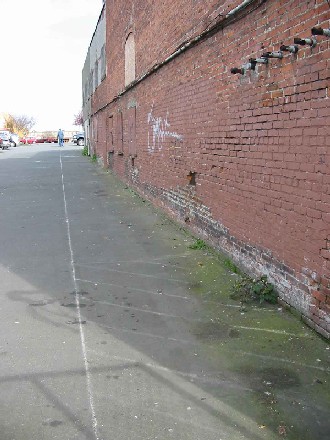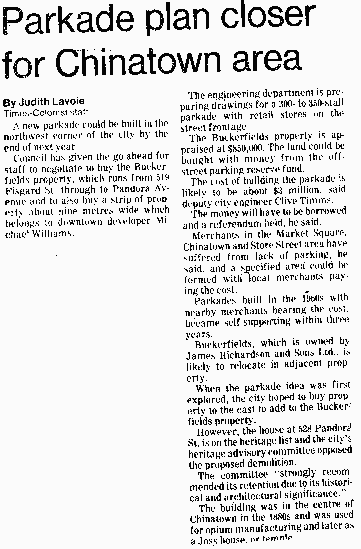|
Theatres
are a significant part of Chinatown's history that
date back to its very early days. In total, Victoria's
Chinatown has been the home of five different theatres.1 Some were
built
in the early days when the Chinese community was just settling,
others were established after Chinatown had expanded and
further developed. The theatres were usually situated within
city blocks, surrounded by other buildings and accessible
only through a maze of alleys.2 Within the block surrounded
by Government Street, Fisgard Street, Store Street and
Pandora Avenue is an alley called Theatre Alley. It is
no longer there, but on the concrete where it used to be
are paint markings showing its location. These photographs
were taken on 20 March 2003 to show what Theatre Alley
looks like today as well as an example of what it may have
looked like had it survived.
 |
 |
The
theatres were not only used for entertainment such as plays
and traditional presentations, they were also a place for
people to gather for meetings.3 Perhaps these meetings
were of members of the same community back home in China.
Or maybe merchants or other significant members of
the community would gather to discuss issues relevant to
the success of the community. These meetings would sometimes
get out of hand as gatherers would argue their opinions.
Consequently, theatres were common venues for demonstrations
and riots.4
Over
time, the theatres have been demolished one by one. In
1889, one of the theatres was torn down to make room
for the Esquimalt and Nanaimo Railway Station to be constructed
in Victoria.5 In 1987, the last surviving theatre in Chinatown
was demolished.
Its lot was then used for the location of parkade. This
newspaper article from The Times Colonist's 15
February 1987 publication discusses the city's decision
to demolish
the building:

Although it is difficult to read the article
in some areas, it is possible to learn some of the
history of the theatre from the article. Although the article
describes the building as a former temple and a former opium
factory,
other sources confirm that this building was a theatre at
some point in its rich history. The article finishes by confirming
that the building "was in the centre of Chinatown in the
1880s," which could be true both geographically and socially.
Endnotes
1.Karrie Marion Sebryk, A
History of Chinese Theatre in Victoria, Master's Degree
Thesis(University of Victoria, 1995), 111.
2.Karrie
Marion Sebryk, Chinese Theatre, 112.
3.Karrie
Marion Sebryk, Chinese Theatre, 43. 4.Karrie
Marion Sebryk, Chinese Theatre, 117.
5. Karrie
Marion Sebryk, Chinese Theatre, 117.
To
return to Victoria's Chinatown Homepage, click here.
|